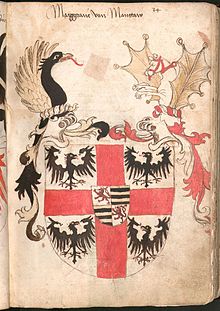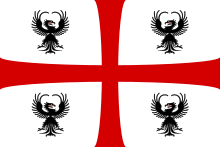Duchy of Mantua



The Duchy of Mantua (Italian: Ducato di Mantova ) was a territory in northern Italy in the late Middle Ages and the early modern period . It arose from the city commune of Mantua in connection with an imperial vicariate . From 1433 the area formed the margravate of Mantua. Since 1530 it was a duchy. The area was ruled by the Gonzaga family . It became part of the immediate Austro-Habsburg rule in Lombardy in the 18th century .
Rise and flowering period
In 1313 Henry VII declared Rinaldo Bonacolsi (called Passerino ) to be imperial vicar. His successor, Emperor Ludwig der Bayer , gave Luigi I Gonzaga the vicariate in 1329 , who then expanded Mantua into a comprehensive rule. In 1403 it was declared a margraviate by the - albeit already deposed - King Wenceslas , which his successor Sigismund confirmed in 1433 for Gianfrancesco I. Gonzaga .
Similar to the Duchy of Modena , Mantua owed its survival to its function as a buffer state . The area was on a strategically very important point between the Duchy of Milan , the Duchy of Parma-Piacenza , the Duchy of Modena, the Papal States , the Duchy of Ferrara and the Venetian Republic . It essentially took up the middle, fertile part of the Po Valley .
Especially in the era of Isabella d'Este , who was married to Gianfrancesco II Gonzaga , the court in Mantua became one of the most important patrons of the arts in Europe.
Based on Habsburg
In the 16th century Mantua was closely connected with the Habsburgs . In 1508, Margrave Gianfrancesco II Gonzaga participated in the League of Cambrai , which was directed against Venice. In recognition of the Gonzaga's loyal support for his policy, Charles V made his son Federico II Gonzaga duke in 1530. The Margraviate of Montferrat was added to this between 1536 and 1559 . This lay between the Duchy of Savoy , the Duchy of Milan and the Duchy of Parma-Piacenza. The dukes of Mantua controlled eastern and western northern Italy for the emperor. Attempts to incorporate the Duchy of Milan failed. The Gonzaga family therefore remained overall too weak, despite considerable prosperity, to be able to pursue their own policy independent of Habsburg.
Conflicts over the duchy
Duke Charles Emanuel I of Savoy waged war between 1613 and 1617 to win the Duchy of Mantua or at least Montferrat. He met the resistance of Spain, Austria and Venice and had to give up this attempt.
After the main line of the Gonzaga family died out in 1627, Emperor Ferdinand II tried to collect the duchies of Mantua and Montferrat as a settled fiefdom . This led to the Mantuan War of Succession of 1630/31 with France. For France, the control of Mantua and Montferrat was of considerable importance, because it was able to gain a significant position of power in northern Italy. The conflict, in which Savoy and other states were involved, was conducted without consideration for the civilian population. In 1630 Mantua was conquered by the imperial family, but the demands of the Thirty Years' War in Germany made the emperor largely give in in 1631. As a result, the land came to a branch line of the Gonzaga under the Duc de Nevers. This had to give up part of the Duchy of Montferrat to Savoy. The Duchy of Mantua lost three quarters of its inhabitants in the course of the War of Succession and the dispute left the state finances completely in ruins. As early as the 1680s, the duchy had to sell the strategically important Casale to France.
The End
During the War of the Spanish Succession , Emperor Leopold I seized the Duchy of Mantua because the last Duke Ferdinando Carlo von Gonzaga-Nevers had sided with France. The area was united with the already Habsburg duchy of Milan. The rest of Montferrat fell to Savoy in 1703.
Verdi
Giuseppe Verdi's opera Rigoletto is set in Mantua.
Regents
Gonzaga line
- Luigi I (city lord of Mantua 1328-1360)
- Guido (1360–1369, Count of Mantua since 1362)
- Luigi II (1369-1382)
- Francesco I (1382-1407)
- Gianfrancesco I (1407–1444, Margrave of Mantua since 1433)
- Luigi III. called "il Turco" (1444–1478)
- Federico I (1478-1484)
- Gianfrancesco II (1484-1519)
- Federico II (1519–1540, Duke of Mantua 1530)
- Francesco III. (1540–1550)
- Guglielmo (1550–1587)
- Vincenzo I (1587-1612)
- Francesco IV (1612)
- Ferdinando (1612-1626)
- Vincenzo II (1626-1627)
Gonzaga-Nevers line
- Carlo I (1630–1637), Duke of Nevers and Rethel
- Carlo III. (1637–1665), Duke of Nevers and Rethel until 1659
- Carlo IV (1665-1708)
literature
- Wolfgang Altgeld , Rudolf Lill (Hrsg.): Little Italian history. Federal Agency for Civic Education, Bonn 2005, ISBN 3-89331-655-8 .
- Gerhard Köbler : Historical lexicon of the German countries. The German territories from the Middle Ages to the present. 4th, completely revised edition. CH Beck, Munich 1992, ISBN 3-406-35865-9 , p. 371.
Individual evidence
- ^ Fritz Trautz : The imperial power in Italy in the late Middle Ages. In: Heidelberger Jahrbücher. Volume 7, 1963, pp. 45-81, here p. 76.

